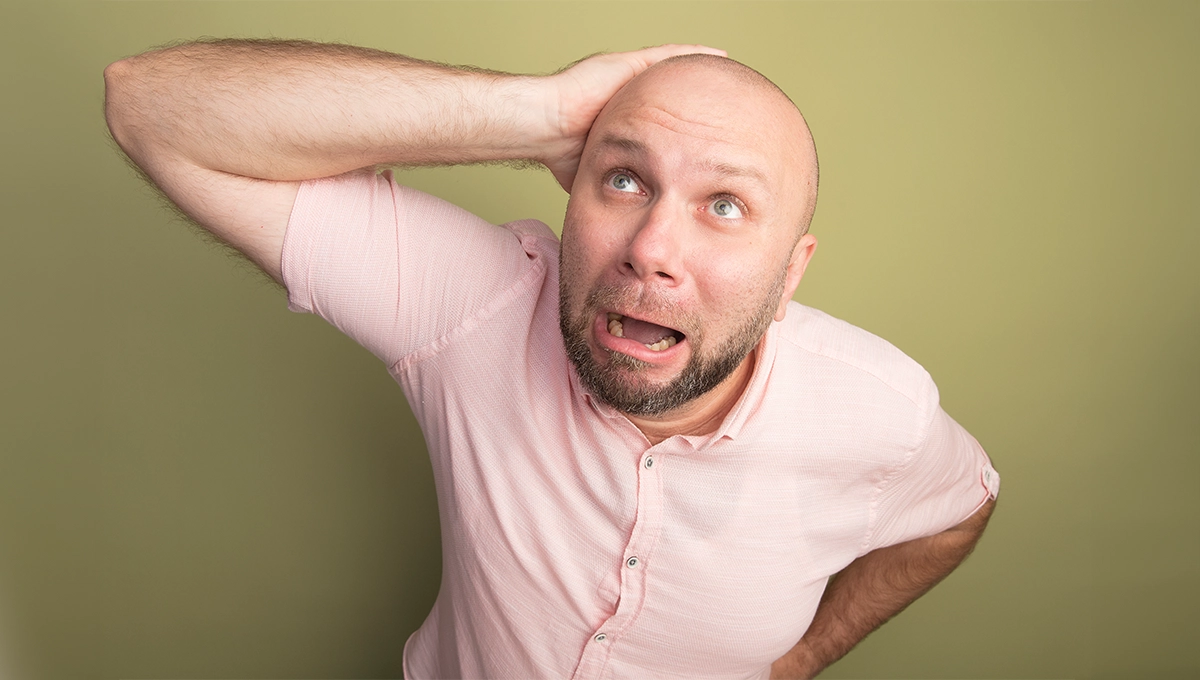
Male pattern baldness (androgenetic alopecia) is a common condition affecting two-thirds of men. With age comes an increasing risk of hair loss. The condition causes hair to gradually become thin on the temples and crown of the head. While predominantly a male condition, male pattern baldness can also affect some women.
So, what causes male pattern baldness? Genetics is what causes hair loss in men. According to research, male sex hormones are primarily responsible for causing hair loss in men. A health condition may be what causes alopecia, such as thyroid disorders, nutritional deficiencies, or autoimmune diseases.
Today, we will discuss male pattern baldness, including its causes, symptoms, treatments, and prevention.
What is Male Pattern Baldness?
Male pattern baldness is a genetically determined condition that causes progressive hair loss. It usually starts with a receding hairline (forming an M shape) or thinning hair at the crown of the head. Some men can have a single bald spot initially. In severe cases, some men can experience complete receding until most of the hair is gone. Women often experience hair loss at the crown and front hairline.
For male or female pattern baldness diagnosis, a complete physical evaluation of the face, scalp, and nails is needed. Hair-pull tests, dermoscopy, scalp biopsy, and laboratory testing are some diagnostic tools that may be used in some cases.
Androgenetic Alopecia: The Root Cause of Male Pattern Baldness
At its core, the root causes of male pattern baldness are hormones and genetics. Having a family history of baldness is likely to increase your susceptibility to hair loss.
Each hair has a growth cycle, which is regulated by the male hormone dihydrotestosterone (DHT), a type of androgen. Androgens are a group of male sex hormones that play a crucial role in male development, including hair growth on the scalp, face, chest, genitals, and underarms.
When DHT causes the hair follicles to shrink gradually over time, they tend to produce thinner strands of hair. Eventually, the hair follicles become so weak that they cannot grow hair, leading to baldness.
Here is how male and female pattern baldness differ:
*Men typically lose hair at the temples and crowns, whereas females often experience baldness all over their scalp or in patches.
*Male pattern baldness may lead to complete baldness in severe cases. On the other hand, women usually retain some hair.
*Although both are influenced by hormones, the hormones are different and affect hair loss in different ways.
Other Causes of Hair Loss in Men and Women
While genetics and hormonal factors play a key role, there are additional causes, too. Knowing what causes balding can make a difference in treating or preventing the condition. So, here are they:
*Alopecia areata: It’s an autoimmune disorder where the immune system attacks hair follicles, leading to hair loss.
*Traction alopecia: Pulling your hair back too tightly can lead to this condition.
*Telogen effluvium: It’s a temporary form of hair loss triggered by stress, illness, or sudden changes in diet.
Here are some medical conditions that can contribute to hair loss:
*Thyroid disorders: Underactive thyroid or hypothyroidism and overactive thyroid or hyperthyroidism can cause you to lose hair.
*Lupus: You can experience hair loss in patches if you have this autoimmune disease.
*Iron deficiency anemia: Low iron levels in the blood can cause hair loss.
*Nutritional deficiency: If your body is lacking essential vitamins and minerals (biotin, zin, or vitamin D), you may be more prone to losing hair.
*Scalp infections: Those who have conditions like fungal or ringworm infections can experience damaged hair follicles and hair loss.
Symptoms and Stages of Male Pattern Baldness
Symptoms of male pattern baldness:
* Thinning hair on the crown
* Hair thinning near temples
* Receding hairline forming an M or U shape
* Bald spot on the crown
* Decrease in hair volume
Initially, you start noticing thinning hair at the temples or crown of the head. As the condition progresses, hair loss can become more noticeable, with a receding hairline forming on the crown. Here are the types of male pattern baldness:
*Telogen Effluvium: It’s a type of hair loss that occurs when large numbers of hair follicles enter the resting phase (telogen) of the hair growth cycle, and the next growth phase does not begin.
*Anagen Effluvium: This is another type of male pattern baldness that results from a medical treatment, like chemotherapy.
*Alopecia Areata: It’s an autoimmune condition that can affect children and adults. It causes you to lose hair from the scalp in small patches.
Male pattern baldness usually follows a predictable pattern, and it can vary from person to person. But here are some common patterns:
*Early stages involve thinning hair at the temples or crown
*In the intermediate stages, the hairline continues to recede, forming a bald spot on the crown
*Advanced stages involve a significant portion of the scalp becoming bald
The rate of progression varies. Some men experience rapid hair loss, while others may have a slower rate of progression.
What Causes Thinning Hair, Male Pattern Baldness in Females?
Unlike men, who often lose hair at the temples and crowns, women experience thinning hair all over the scalp or in patches. There can be a combination of factors that can lead to male pattern baldness in females. However, male pattern baldness in males is primarily caused by genetics and hormones. Here are the causes of female baldness:
* Changes in hormones: Several types of hormonal changes can cause women to lose hair. Hair loss in women is natural during menopause, pregnancy, and childbirth and as you age.
* Stress: Women are likely to have hair loss due to physical stress, like while giving birth or having surgery. Emotional stress may also cause hair loss in females.
* Medications: Certain medications have the potential to prevent hair from growing the right way.
* Hair styling: The way you style or wear your hair can also be a reason behind hair loss.
* Diet and nutrition: Significant changes in your diet can cause you to lose hair as your body reacts to the change.
Treatments for Male Pattern Baldness
These are common treatment options for male pattern hair loss:
* Medications: Topical Minoxidil (Rogaine) and oral Finasteride (Propecia) can be effective medicines that help slow hair loss and promote hair regrowth. The former one stimulates the hair follicles to grow new strands of hair. The latter works by blocking the production of male hormones that cause hair loss.
* Hair transplants: You can also opt for surgical options like hair transplants, where hair follicles from one part of the scalp are transplanted to bald areas. You may need multiple treatments to see full results. It’s an expensive and invasive treatment that involves removing hair from areas with active hair growth and transplanting them to thinning areas of your scalp.
* Laser Therapy: Noninvasive treatments include hair growth devices like a red light hair growth cap, which is an excellent option for growing back hair. These caps emit red light and near-infrared light at 660 nm and 850 nm to stimulate hair growth. The light energy penetrates deep into the hypodermis to activate and strengthen hair follicles. You may experience a noticeable increase in your hair volume after 21 to 28 weeks of regular use.

The effectiveness of these treatments may vary. Combining different treatments may yield better results, but make sure to see a healthcare professional to determine the most suitable treatment for you.
Can Hair Loss Be Prevented?
There’s no guaranteed way to prevent hair loss but taking certain strategies may help. Research says that stress has a role to play in hair loss. Practice effective stress management techniques. Starting treatment early can be more effective in slowing hair loss, while promoting hair growth. Using proper hair care products can also be a good starting point. Avoid harsh ingredients and excessive hair styling techniques that damage hair follicles.
Conclusion:
Male pattern baldness is a common condition caused by genetics and hormones. There’s no cure for this condition, but you can still play an active role in treating it. If you notice alopecia symptoms, it’s advisable to consult a dermatologist to explore your treatment options.
FAQs on Male Pattern Baldness
What is the primary cause of male pattern baldness?
Genetics and male sex hormones (androgens) are the primary causes of male pattern baldness. If you have a family history, you are more likely to experience hair loss.
Can female pattern baldness have the same treatment as male pattern baldness?
Some treatments are common in both conditions, but there can be differences. Minoxidil and Finasteride are common treatments for both. Treatments specific to female pattern hair loss are hormone therapy and antiandrogens.
Are there any side effects of treatments for male pattern baldness?
Yes, there are certain side effects of certain hair loss medications, including dryness, burning, scaling, swelling, and irritation on the scalp. Hair transplants, laser therapy can also have side effects like scarring, redness. If you notice major effects, consult your healthcare provider right away.
How to differentiate male pattern baldness from normal hair fall?
Usually, male pattern baldness starts at the temples and crown. Normal hair loss, however, can occur anywhere on the scalp, and there’s no specific pattern. Male pattern baldness is often progressive and long-lasting, whereas normal hair loss resolves on its own.


